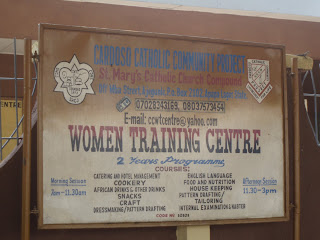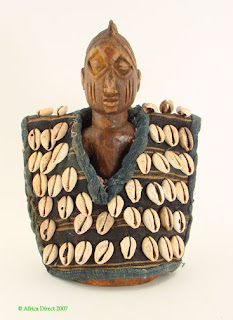It was a treat to meet and visit with Sister Bernadette. She is warm and thoughtful and also very educated. She lived in California for 6 years, getting two Masters degrees and a doctorate at Berkeley in areas of theological studies. As we toured Cardoso, she reached out to greet and visit with the people around her. Her caring for them was evident.
It was a Muslim holiday, so much of the center was quiet, but we enjoyed getting a look at some of the many good works they do there. There are seven nuns in the convent here at this center, which is supported by St. Mary's Catholic Church. They have a staff of around 100 helping them with their works, with the main purpose of empowering women to improve their lives.
The clinic was open on the holiday -- the nuns and staff work 6 days a week at the clinic, and on Sunday the nuns are busy with the work of the church, so they don't get a lot of down time.

This waiting area is often full of people, they said. They see 70-100 people a day. They have ante-natal care and training, they give immunizations, and provide all kinds of health services for the local community. They also have feeding times for malnourished children. People pay what they can for their services.

This is the staff of the lab, where they have some pretty good equipment. They do their own disease testing. They will do HIV testing upon request and give counseling and direct those testing positive to government centers where they can get free drug therapy.
The pharmacy was not really well-stocked, but better than in many charity clinics I've seen here. The clinic overall was very impressive (considering the Nigerian standard) in their facilities.
While we were visiting the clinic and meeting the nuns working there, the noon bell rang and the sisters explained that it was a reminder for them to stop their work and invite everyone in the center to join them in prayer. It was sweet to see their devotion and be a part of their group prayer -- just as visiting the Muslim world last week with their regular calls to prayer, it was a reminder to me of the importance of regular connection to God through prayer.
Education is a central focus to the Cardoso mission. They have schools ranging from pre-school through adult education. They were all quiet on this holiday. The buildings all looked very well cared-for.
Sister Bernadette said that often this library is filled with members of the community enjoying a place to read.

They are expanding their secondary school and are in the process of building and equipping their science lab. They are hoping to receive donated funds to allow them to finish these rooms and provide materials so they can properly teach the sciences.

Sister Bernadette said the secondary classrooms are also used for adult education in the evenings. But a central focus of their education is with women's training classes. They just had a graduation ceremony (their women's training educational year runs with the calendar year) where 100 women graduated from their program. They run a two-year program which trains women in various areas to prepare them for meaningful employment or with skills allowing them to start their own businesses. They teach tailoring skills, cake decorating, hotel management, English, and a number of other classes.

To travel to Cardoso, we were glad to drive on highways more passable because of the Muslim holiday, and as we neared the church compound, we passed through a busy market area teeming with activity. The mass of humanity and need here in Lagos is overwhelming at times, but it's rewarding to visit places like Cardoso where they are making a great contribution in making better the lives of many Nigerians.
They are expanding their secondary school and are in the process of building and equipping their science lab. They are hoping to receive donated funds to allow them to finish these rooms and provide materials so they can properly teach the sciences.
Sister Bernadette said the secondary classrooms are also used for adult education in the evenings. But a central focus of their education is with women's training classes. They just had a graduation ceremony (their women's training educational year runs with the calendar year) where 100 women graduated from their program. They run a two-year program which trains women in various areas to prepare them for meaningful employment or with skills allowing them to start their own businesses. They teach tailoring skills, cake decorating, hotel management, English, and a number of other classes.
To travel to Cardoso, we were glad to drive on highways more passable because of the Muslim holiday, and as we neared the church compound, we passed through a busy market area teeming with activity. The mass of humanity and need here in Lagos is overwhelming at times, but it's rewarding to visit places like Cardoso where they are making a great contribution in making better the lives of many Nigerians.


